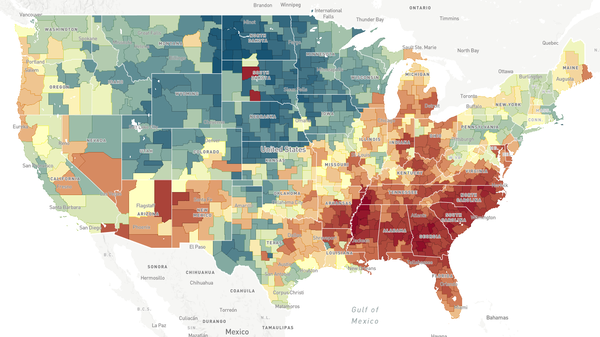The news came as a loud wake-up call.
And Charlotte responded, Garmon-Brown says. She was drafted to co-chair a task force, formed by the Foundation for the Carolinas, to develop a plan to attack the problem.
The task force's report identified early childhood development, college and career readiness, family stability and strong social networks as key factors that enhance upward mobility. It singled out segregation as a key obstacle. And now, Charlotte officials are learning to use the Opportunity Atlas to effectively target some remedies, things like pre-K programs and affordable housing.
Frank Barnes, the chief equity officer for Charlotte-Mecklenburg Schools, says the Opportunity Atlas will be very helpful in shaping future decisions.
Enlarge this imageThis map, a screenshot from The Opportunity Atlas, shows household income in 2014-2015 for African-Americans born between 1978 and 1983 to low-income parents. Sedgefield Middle School is in a part of Charlotte where blacks who grew up in low-income households tended to stay low-income. The Opportunity Atlas/Screenshot by NPR
The Opportunity Atlas/Screenshot by NPRThis map, a screenshot from The Opportunity Atlas, shows household income in 2014-2015 for African-Americans born between 1978 and 1983 to low-income parents. Sedgefield Middle School is in a part of Charlotte where blacks who grew up in low-income households tended to stay low-income.
The Opportunity Atlas/Screenshot by NPR"The Foundation for the Carolinas have brought a lot of partners to the table to think about how to act on these data and I think that's the power; it's in the community collaboration and the community partnership," he says.
The future is already taking shape at Sedgefield Middle School. It's located in a majority-white neighborhood not far from downtown Charlotte, but the school's population doesn't reflect the neighborhood. Assistant Principal Eric Tornfelt says only 4 percent of the school's student body is white; the rest is almost evenly split between African-American and Hispanic students.
Tornfelt acknowledges the school has challenges. "There is significant opportunity for growth," as he puts it. "We have some great kids."
Enlarge this imageEric Tornfelt, assistant principal at Sedgefield Middle School. The school is located in a majority white neighborhood not far from downtown Charlotte, but the school's population doesn't reflect the neighborhood. John Ydstie/NPR
John Ydstie/NPREric Tornfelt, assistant principal at Sedgefield Middle School. The school is located in a majority white neighborhood not far from downtown Charlotte, but the school's population doesn't reflect the neighborhood.
John Ydstie/NPRIt's not unusual for a public school in Charlotte to have a student body that's largely people of color. That is because many white students attend private schools or public schools outside their neighborhoods. Those choices can hinder upward mobility for children who attend neighborhood public schools.
James E. Ford, a former North Carolina teacher of the year, is working with Sedgefield's administration to make the school more racially balanced. Ford, now an education consultant, says two local elementary schools have already merged for that reason.
"Eventually, something similar is going to happen here," he says. "The demographics here are going to shift quite a bit. It's majority black and brown now, but in the coming years it will change, it'll start to look more like the neighborhood."
The Two-Way
'Early School Leavers' Face Dismal Social And Economic Prospects
But there's another challenge here, beyond segregation — the lack of social networks minority children need to succeed.
The Sedgefield neighborhood is more affluent than a nearby majority-black neighborhood called Southside Park. But the Opportunity Atlas shows that African-American men who grew up in Sedgefield in the 1980s and '90s are doing worse now than their counterparts from Southside Park. The median income of African-American men in Sedgefield is $5,000 less per year than their neighbors in Southside Park.
Ford says that might surprise people.
"We may assume because the area is affluent, like, 'that's a high-opportunity area,' when the truth is that may not be a high-opportunity area, according to all the metrics that we're looking at," he says.
Enlarge this imageJames E. Ford, a former North Carolina teacher of the year, is working with Sedgefield Middle School's administration to make the school more racially balanced. John Ydstie/NPR
John Ydstie/NPRJames E. Ford, a former North Carolina teacher of the year, is working with Sedgefield Middle School's administration to make the school more racially balanced.
John Ydstie/NPRIn this case it may be that the majority black neighborhood of Southside Park offers young black men the social networks, friends, extended family and churches that help them get ahead. Those kinds of networks might not be accessible to them in a majority white neighborhood.
Ford says the Opportunity Atlas should help reduce misconceptions about economic mobility.
"So this permits us to start making really smart and really intentional decisions so that, 20 to 30 years down the line we can look and say, 'Yeah, that was the right call,' " he says.
Code Switch
A Battle For Fair Housing Still Raging, But Mostly Forgotten
Charlotte is already taking significant steps in that direction. Mecklenburg County, which encompasses the city, has committed to providing pre-K for all children. And the city has a $50 million bond issue for affordable housing on the November ballot. Matching private donations could boost the total to over $100 million.
Harvard's Chetty says he hopes the Opportunity Atlas will help communities across the country revive the American dream in their neighborhoods.
"We hope citizens, local policymakers, nonprofits, people working on these decisions can use [the data tool] to make better decisions," he says.
The Opportunity Atlas is now available to the public. You can find it at: http://www.opportunityatlas.org/
A Nation Engaged: Sparking Conversations That Matter
A Nation Engaged: Is This Still A Land Of Economic Opportunity?
The Two-Way
One Chart That Explains A Big Issue Behind Baltimore Protests

Comment